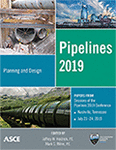Pipelines 2019
Development of a Prescriptive Approach for Seismic Design of Water Mains
Publication: Pipelines 2019: Planning and Design
ABSTRACT
Many water systems have performed poorly in major earthquakes. Water supplies needed to fight fires or for health and safety of the public during post-disaster recovery have been disrupted. Although many water utilities have seismically upgraded their tanks, pump stations, and other “vertical” structures, most U.S. water utilities still have vulnerable watermain networks. Over one thousand watermain failures occurred in each of the 1994 Northridge, 1995 Hyogo-ken Nanbu (Kobe), 2011 Christchurch, and 2011 Tohoku earthquakes. These watermain failures led to depressurization in large areas of the affected water systems and lengthy restoration times. Japan has pioneered the use earthquake-resistant design standards for watermains and the installation of seismic resistant pipe. Watermains built using these earthquake-resistant design standards and seismic resilient pipe systems have been shown to provide excellent seismic performance. Although many U.S. utilities located in areas of high seismicity are beginning to use earthquake-resistant watermains, there is not a uniform U.S. standard that stipulates seismic design requirements for new watermains. To decrease the seismic vulnerability of watermain networks in the United States, the American Society of Civil Engineers’ (ASCE) Utility Engineering and Surveying Institute (UESI), in collaboration with ASCE’s Infrastructure Resilience Division (IRD), is developing a manual of practice (MOP) for water and wastewater pipeline seismic-resistant design. The intention of this MOP is to serve as a pre-standard for seismic design of all new water and wastewater piping in the U.S. and Canada. Detailed, site-specific analysis is warranted for transmission mains and some other critical watermains. However, most pipelines do not require this type of analysis. To simplify the design methodology for the less critical pipelines that comprise the majority of most water system networks, a prescriptive procedure is being developed. The prescriptive procedure will utilize the pipelines level of service (criticality), level of redundancy, the seismicity, and geotechnical hazard exposure to assist the watermain designer in selecting pipeline performance criteria. The pipeline performance criteria will be established in terms of required system flexibility (e.g., joint deflection for segmented pipelines), ductility (e.g., strain capacity), and strength for continuous and segmented pipelines. It is expected that pipe manufacturers would test their pipe products and demonstrate different performance levels. The goal is to ensure that the pipe materials perform as expected after a seismic event. The prescriptive procedure is intended to be a simple, straight forward method that will allow civil engineers to design and specify new pipe without specialized geotechnical and earthquake engineering expertise for most commonly encountered design conditions. This paper describes the proposed prescriptive procedure and presents design examples.
Get full access to this article
View all available purchase options and get full access to this chapter.
REFERENCES
American Society of Civil Engineers (ASCE). (2016). ASCE/SEI 7-16: Minimum Design Loads and Associated Criteria for Building and Other Structures.
American Lifelines Alliance (ALA). (2005). Seismic Design Guidelines for Water Pipelines.
Davis, C. A. (2008). “Assessing Geotechnical Earthquake Hazards for Water Li feline Systems with Uniform Confidence.” ASCE Geotechnical Earthquake Engineering and Soil Dynamics IV. May 18-22, 2008. Sacramento, CA. paper 4291.
Davis, C.A., Rajah, S., Wham, B.P. and Heubach, W.F. (2019). Strain Demands on Buried Pipelines from Earthquake-Induced Ground Movements. Paper to be published at the 2019 ASCE Pipelines Conference.
Committee on Gas and Liquid Fuels of the American Society of Civil Engineers Technical Council on Lifeline Earthquake Engineering (ASCE TCLEE). (1984). Guidelines for the Seismic Design of Oil and Gas Pipeline Systems. American Society of Civil Engineers.
Hara, Takeshi. (2016). “Overview of Japan’s Seismic Design Guideline for Water Facilities.” PowerPoint presentation made to the ASCE UESI Seismic Design for Water and Wastewater Committee.
Idriss, I.M. and Boulanger, R.W. (2008). Soil Liquefaction During Earthquakes. Earthquake Engineering Research Institute.
International Organization for Standardization (ISO). (2006). ISO 16134: Earthquake- and Subsidence- Resistant Design of Ductile Iron Pipelines. First Edition. ISO 16134:2006(E).
Japan Water Works Association. (1997). Seismic Design and Construction for Water Supply Facilities, Briefly English Transleted(sic) Edition.
McMullins, Roberts. (2017). “Pipe Criticality Categories,” ASCE UESI Task Committee on Seismic Design of Buried Pipelines.” working paper for ASCE UESI Seismic Design for Water and Wastewater Pipelines Task Committee.
Miyajima, M. (2014). “Performance of Earthquake Resistant Drinking Water Pipeline During the 2011 Tohuku Earthquake in Japan.” Proceeding of the 10thNational Conference on Earthquake Engineering.
O’Rourke, M.J. and Liu, X. (1999). Response of Buried Pipelines Subject to Earthquake Effects. Multidisciplinary Center for Earthquake Engineering Research.
SEAOC/OSHPD/USGS Online Calculator. https://seismicmaps.org/.
Wham, B.P., Davis, C.A. and Rajah, R. (2019). Axial Connection Force Capacity Required for Buried Pipelines Subjected to Seismic Permanent Ground Displacement. Paper to be Presented at the 2019 ASCE Pipelines Conference.
Youd, T.L. and Idriss, I.M. (2001). “Liquefaction Resistance of Soils: Summary Report From the 1996 NCEER and 1998 NCEER/NSF Workshops on Evaluation of Liquefaction Resistance of Soils.” Journal of Geotechnical and Environmental Engineering. American Society of Civil Engineers. Vol. 27. No. 4.
Zhang, Robertson P.K. and Brachman, R.W. (2004). “Estimating Liquefaction-Induced Lateral Displacements Using the Standard Penetration Test or Cone Penetration Test.” Journal of Geotechnical and Environmental Engineering. American Society of Civil Engineers. Vol. 130. No. 8.
Information & Authors
Information
Published In
Pipelines 2019: Planning and Design
Pages: 309 - 318
Editors: Jeffrey W. Heidrick, Burns & McDonnell and Mark S. Mihm, HDR
ISBN (Online): 978-0-7844-8248-3
Copyright
© 2019 American Society of Civil Engineers.
History
Published online: Jul 18, 2019
Published in print: Jul 18, 2019
Authors
Metrics & Citations
Metrics
Citations
Download citation
If you have the appropriate software installed, you can download article citation data to the citation manager of your choice. Simply select your manager software from the list below and click Download.
